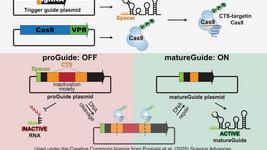CMN Weekly (23 May 2025) - Your Weekly CRISPR Medicine News
By: Gorm Palmgren - May. 23, 2025
Top picks
- ROS-driven nanomotors exploit elevated reactive oxygen species in the tumour microenvironment as fuel for self-propulsion, enabling CRISPR-Cas9 plasmids targeting LDHA to achieve enhanced penetration into dense solid tumours. The hemin-cored nanoparticles consume extracellular ROS via catalytic decomposition to generate directional movement. Upon cellular uptake, they undergo heme oxygenase-1-mediated degradation to release both therapeutic cargo and carbon monoxide. This dual mechanism achieved 93.9% tumour growth suppression whilst enhancing CD8+ T cell infiltration through simultaneous metabolic disruption and immunogenic cell death reversal.
- Swiss researchers have used prime editing delivered via mRNA-lipid nanoparticles in a phenylketonuria mouse model. They achieved up to 47.4% editing efficiency at the Dnmt1 locus and 20.7% correction of the pathogenic Pahenu2 mutation, successfully reducing blood L-phenylalanine levels below therapeutic thresholds. The researchers developed both dual-delivery and simplified co-delivery approaches using PE7 mRNA encapsulated in LNPs, demonstrating the scalable therapeutic potential for genetic liver diseases.
Research
- CRISPR-Cas9 single-cut editing with SpCas9-LRVQR successfully restored dystrophin expression by reframing exon 53 in patient-derived iPSCs and a humanised DMD mouse model with exon 52 deletion. AAV9 delivery via intraperitoneal and facial vein injection effectively targeted multiple skeletal muscles and heart tissue. The approach improved key disease markers, including histopathology, grip strength, and serum creatine kinase levels.
- Using CRISPR-Cas9, researchers in Sweden and the UK created isogenic iPSC-derived neurons with ALS-causative mutations in FUS and TARDBP to explore early disease mechanisms. Single-cell RNA sequencing revealed motor neuron-specific transcriptional dysregulation, largely linked to gain-of-function effects, with impaired mitochondrial function emerging as a shared, early hallmark. These findings identify mitochondrial pathways as potential therapeutic targets in genetically diverse forms of ALS.
- Researchers have compared chemically synthesised Cas9 gRNAs and found that measuring only indels underestimates activity, as most gRNAs perform similarly when all DNA cleavage outcomes are considered. They developed a linear prediction model accessible via a genome browser and showed that Cas9 produces more unintended large-scale repair events than Cas12a, which has implications for gene therapy safety.
- CRISPR-Cas9 targeting removes less than 1% of highly abundant transcripts in single-cell RNA-seq libraries, redistributing approximately half of sequencing reads to detect low-abundance transcripts that are typically obscured. scCLEAN successfully enhanced biological signature detection in heterogeneous immune cells and homogeneous vascular smooth muscle cells whilst proving versatile across third-generation sequencing platforms like single-cell MAS-Seq for improved transcript-level discovery.
- Researchers at YolTech Therapeutics and various institutions in China have developed a new adenine base editor (ABE) that matches the efficiency of the widely used ABE8e while offering significantly improved editing precision. The novel editor, named hpABE5.20, demonstrated reduced off-target effects and successful therapeutic applications in disease cell models, humanised mice, and non-human primates. The findings were published recently as a preprint on bioRxiv.
- In an article published earlier this week in Nature, researchers at Stanford University described CRISPR-TO, a new spatial transcriptomics technology that enables precise control of RNA localisation inside cells. CRISPR-TO uses a catalytically-dead form of Cas13 (dCas13) to precisely control endogenous RNA localisation in living cells, which enables targeted RNA transport to subcellular compartments and along microtubules. Using CRISPR-TO, the team discovered that controlling where RNA molecules are positioned within neurons directly impacts how proteins are made locally and affect cell behaviour. Specifically, relocating β-actin mRNA enhanced the formation of cellular protrusions that help neurons explore their environment while simultaneously hindering the cell's ability to regenerate damaged connections.
- CRISPR-Cas9 targeting was used to selectively remove non-variable RNAs, including ribosomal and mitochondrial transcripts, from single-cell RNA-seq libraries, outperforming computational methods like SoupX in both scope and effectiveness. Applied to human intestinal tissue samples from 17 patients, this approach maintained sequencing quality at half the depth whilst preserving cell type composition and gene expression patterns. The method offers a cost-effective alternative that reduces sequencing expenses without compromising biological data integrity.
- Researchers systematically screened 2015 DNA processing genes to map how cellular repair pathways influence cytosine base editor outcomes. They found that mismatch repair factors drive C•G to T•A conversions, while the E3 ubiquitin ligase RFWD3 mediates C•G to G•C changes, with XPF and LIG3 facilitating reversion to the original sequence.
- Using AlphaFold3 structural predictions, researchers engineered an enhanced Fanzor2 nuclease system (enNlovFz2) that achieved 11-fold improved genome-editing efficiency compared to wild-type, with expanded target recognition capabilities. The system successfully disrupted genes in mouse embryos and restored dystrophin expression in a Duchenne muscular dystrophy mouse model via single adeno-associated virus delivery. This demonstrates the therapeutic potential of compact eukaryotic RNA-guided nucleases as alternatives to CRISPR-Cas systems.
- CloneSelect is a new multi-kingdom genetic barcoding system that uses CRISPR base editing to retrospectively isolate specific cell clones showing desired phenotypes from heterogeneous populations. The method involves stable DNA barcode tagging followed by barcode-specific CRISPR activation of reporter genes for target clone retrieval from stored cell pools. CloneSelect proved versatile across human embryonic kidney cells, mouse embryonic stem cells, human pluripotent stem cells, yeast, and bacteria, offering compatibility with single-cell RNA sequencing.
Clinical
- Precision BioSciences presented initial safety data from its ELIMINATE-B Phase 1 trial of PBGENE-HBV at the 2025 ASGCT meeting held last week in New Orleans. The company reported that four patients across two dose cohorts (0.2 mg/kg and 0.4 mg/kg) experienced no serious adverse events or dose-limiting toxicities following treatment with the PBGENE-HBV, which is a meganuclease-based in vivo gene-editing therapeutic candidate designed to eliminate chronic hepatitis B. According to a slide deck presented at that meeting, adverse events following treatment with PBGENE-HBV were generally mild and transient, resolving within 1-7 days, with no clinically significant laboratory abnormalities observed. The trial, which began enrolment in December 2024, is actively recruiting across multiple global sites, including Hong Kong, Moldova, New Zealand, the United States, and the United Kingdom. Antiviral efficacy data is expected to be shared following completion of all planned dose administrations.
- Intellia Therapeutics' Phase 1 clinical trial of CRISPR-Cas9 gene editing therapy nexiguran ziclumeran demonstrated a sustained 90% reduction in disease-causing TTR protein levels at two years following a single dose. The treatment showed clinically meaningful improvements in neuropathy scores in hereditary ATTR amyloidosis patients, including those who had previously progressed on existing therapies.
Industry
- CRISPR Therapeutics and Sirius Therapeutics announced this week a multi-target collaboration to develop novel siRNA therapies. The partnership will bring together complementary capabilities to co-develop and co-commercialise SRSD107, a next-generation, long-acting Factor XI (FXI) small interfering RNA (siRNA) for the treatment of thromboembolic disorders. See the official press release for further details.
- Prime Medicine announced this week that it will undergo strategic restructuring, including the deprioritisation of its chronic granulomatous disease programmes, as well as a cost and workforce reduction to focus on its liver programmes for Wilson's Disease and alpha-1 antitrypsin deficiency. Prime Medicine will also continue its in vivo cystic fibrosis programme with support from the Cystic Fibrosis Foundation and its efforts to develop prime-edited CAR-T products for haematology, immunology and oncology in partnership with Bristol Myers Squibb. See the official press release for further details.
- Be Biopharma's preclinical study of BE-102 employed CRISPR-Cas9 to engineer primary human B cells for continuous alkaline phosphatase secretion, demonstrating sustained therapeutic protein production for over six months following a single administration. The B cell medicine platform uses precision genome editing to insert the human ALPL gene into the CCR5 safe harbour locus, offering a potential alternative to frequent enzyme replacement therapy for hypophosphatasia.
Detection
- Researchers have developed a one-pot assay combining LAMP amplification with CRISPR-Cas12b detection for the monkeypox virus, achieving results within 40 minutes with visual readout capability. Testing on 113 clinical samples demonstrated 100% sensitivity and specificity compared to qPCR, with detection limits of 6.5 viral copies per reaction.
- A new one-step RPA-CRISPR-Cas13a assay can detect the S643N mutation in the mecA methicillin resistance gene ofStaphylococcus aureus, completing detection in under 30 minutes with sensitivity down to 10 copies per reaction. The method streamlines antibiotic resistance testing for MRSA by combining amplification and CRISPR detection in a single procedure.
- Scientists developed a CRISPR-Cas12a system using dual mutations in crRNAs and molecular beacon reporters to detect single nucleotide variants like SARS-CoV-2's D614G and N501Y mutations with enhanced specificity. The method incorporates lateral flow strips for visual detection and successfully identified Omicron variants, providing a platform for monitoring pathogen mutations in clinical settings.
Reviews
- Unlocking the potential of CRISPR-associated transposons: from structural to functional insights. CRISPR-associated transposons (CASTs) are emerging as powerful tools for genome engineering, offering the ability to insert large DNA fragments without creating double-strand breaks. In this recent Trends in Genetics review, Guillermo Montoya and colleagues at the Novo Nordisk Foundation Centre for Protein Research examine their molecular architecture, integration mechanisms, and therapeutic potential.
- CRISPR-Assisted Probiotic and In Situ Engineering of Gut Microbiota: A Prospect to Modification of Metabolic Disorders. This review explores CRISPR-Cas applications for editing gut microbiota genes to address metabolic disorders, highlighting the technique's potential for modifying microbial communities that influence gastrointestinal stability and systemic metabolic processes.
- Harnessing the Microbiome: CRISPR-Based Gene Editing and Antimicrobial Peptides in Combating Antibiotic Resistance and Cancer. This review examines CRISPR-Cas microbiome engineering applications for addressing antibiotic resistance and cancer, exploring how gene editing can enhance host-microbiome interactions and optimise therapeutic outcomes.
- Genome Editing in Gynecological Oncology: The Emerging Role of CRISPR/Cas9 in Precision Cancer Therapy. This review examines CRISPR-Cas9 applications in gynaecological cancers, highlighting the technology's potential for developing gene-targeted therapies that address chemoresistance and tumour recurrence in cervical, ovarian, and endometrial cancers.
- HPV-driven cancers: a looming threat and the potential of CRISPR/Cas9 for targeted therapy. This review explores CRISPR-Cas9 targeting of HPV E6 and E7 oncogenes in cervical and anogenital cancers to restore p53 and pRb tumour suppressor function, discussing the potential for precision oncology approaches that could offer less invasive alternatives to conventional treatments.
News from CRISPR Medicine News
- On Monday, we highlighted a recent study carried out at Full Circles Therapeutics. Researchers developed a novel gene-editing system that significantly enhances targeted gene integration without using viral vectors. The 'enGager' system fuses single-stranded DNA-binding domains to CRISPR-Cas9, forming a tripartite complex that can increase gene knock-in efficiency by up to sixfold compared to standard methods.
- This week's clinical trial update focused on clinical data shared by Prime Medicine earlier this week. The data, shared in a press release on Monday, provides the first indication that prime editing is safe and efficacious in humans. The data was collected from the first patient dosed with PM359 in the first-ever clinical trial of a prime-editing therapeutic. PM359 is an autologous ex vivo haematopoietic stem cell therapy that is prime-edited to correct the most prevalent disease-causing mutation in the p47phox variant of chronic granulomatous disease (CGD), which is expected to affect approximately 25% of all CGD cases.
To get more CRISPR Medicine News delivered to your inbox, sign up to the free weekly CMN Newsletter here.
Tags
ArticleMissing linksNewsCMN WeeklyBe PharmaCRISPR Therapeutics AGIntellia Therapeutics, Inc.Precision BioSciences, Inc.Prime MedicineYolTech Therapeutics
CLINICAL TRIALS
IND Enabling
Phase I
Phase II
Phase III
Gastric Cancer and Colorectal Cancer, CRC, (NCT07166263)
Sponsors:
Base Therapeutics (Shanghai) Co., Ltd.
Sponsors:
Base Therapeutics (Shanghai) Co., Ltd.
IND Enabling
Phase I
Phase II
Phase III
Relapsed or Refractory Acute Myeloid Leukemia, AML, (NCT06541444)
Sponsors:
Base Therapeutics (Shanghai) Co., Ltd.
Sponsors:
Base Therapeutics (Shanghai) Co., Ltd.
IND Enabling
Phase I
Phase II
Phase III







